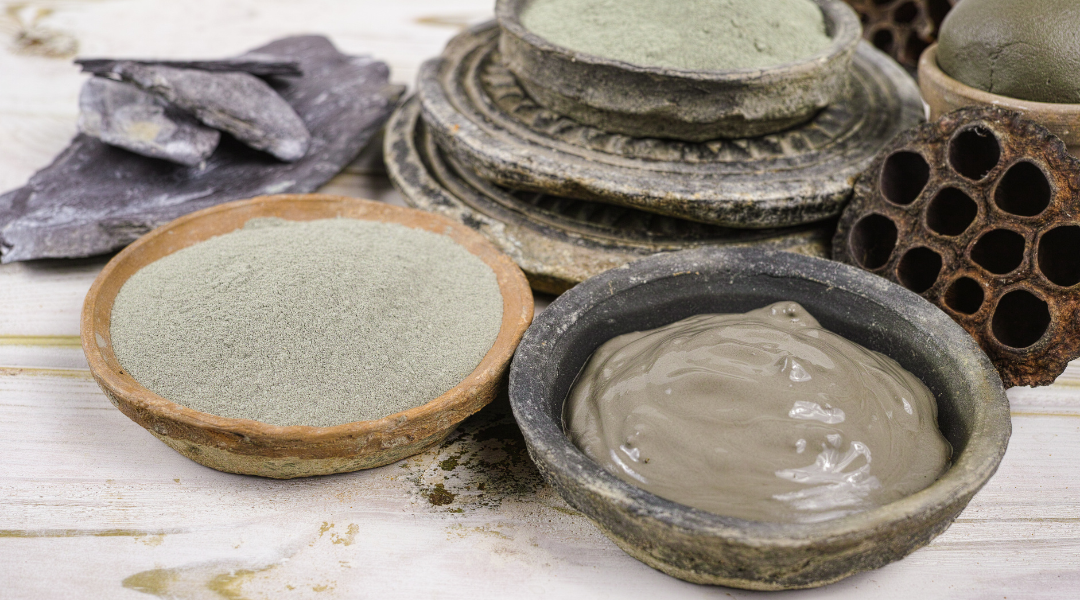Skincare “Hacks” Through The Ages
The Good, The Bad, And The “What Were They Thinking?”

I want my skin to be bright, healthy, and beautiful. My great-great-grandmother had the same desire. And if we trace our way back to the cradle of civilization itself… our most ancient ancestors were also in pursuit of a fresh, soft glow.
Yes, skincare is as old as history itself.
And like anything in history, there are moments of greatness. From nutrient-rich fresh-plucked botanicals to soothing, detoxifying healing clays… these sacred ingredients are no less effective and safe today than they were millennia ago.
But there are also moments of, well, “what the heck were they thinking?”
This is where we begin our exploration of skincare through the ages.
Harmful Skincare Practices From History
Lead-Based Cosmetics… Really?
Lead is highly toxic—even low-level exposure over time can cause irreversible damage to our kidneys and nervous system. However, in ancient Egyptian and Roman societies, the corrosive effects of lead actually helped people conform to the latest “beauty fads.”
Pale skin was a marker of aristocracy. The less you looked like you’d been working in the sun… the more “important” you were. Romans often applied ceruse (lead carbonate) to whiten their faces. In Egypt, people used kohl, often containing lead sulfide, for eye adornment.
But while many didn’t understand the toxicity of these lead-based ingredients…
There were people trying to speak out.
Pliny the Elder, in his revolutionary Historia Naturalis (Natural History), criticized the corrosive effects of lead in skincare, noting how it caused "ulcerations and pallor." Still, the practice persisted.
Shortcuts to short-lived, conformist beauty standards… with warnings about toxicity falling on death ears?
There really is “nothing new under the sun!”
Mercury? Hard pass!
Remember the fuss about mercury in thermometers? In the United States and around the world, this neurotoxin has been largely phased out of our daily lives.
But it took thousands of years for humanity to realize, “yeah, we shouldn’t be rubbing that on our skin.”
In ancient times, people used calomel (mercurous chloride), a mercury compound, to help brighten their skin. The Greek physician Dioscorides even wrote about the many ointments you could create with mercury.
If you went to a Roman physician, fed up with freckles and blemishes, mercury would be the prescription. Even going back to the Egyptian Hearst Papyrus (c. 1450 BC), you’ll find mercury-laced remedies for skin ailments.
Scary stuff. And it wasn’t until the 1930s that the US government even STARTED to regulate mercury usage in skincare and cosmetic products.
Arsenic (it’s as bad as it sounds)
Perhaps no single ingredient exemplifies the dangerous extremes of historical beauty practices better than arsenic, which gained popularity as a cosmetic ingredient during the Victorian era.
The fascination with arsenic began with reports from Austria's Styria region, where residents practiced eating arsenic trioxide, claiming it provided increased endurance, energy, and improved complexions with sparkling eyes and rosy cheeks. This exotic practice captured the imagination of Victorian society, leading to the widespread adoption of arsenic-based beauty products.
Dr. James P. Campbell capitalized on this trend by selling arsenic "complexion wafers" in 1890, guaranteeing they were "absolutely safe and harmless to anybody". These small white chalk wafers were marketed to treat freckles, blackheads, pimples, and other facial "disfigurements" while promoting the pale, “consumptive” aesthetic popular during the Victorian era (yes, looking like you had tuberculosis was actually fashionable).
The irony of arsenic treatment was particularly cruel:
While promising to eliminate hyperpigmentation, prolonged arsenic exposure actually caused dark spots on the hands and feet, worsening the very conditions it claimed to treat (along with other major health complications).

Toxins in Modern Skincare
Don’t think for a second that we’ve got it all figured out now. The skincare practices prevalent in our society may seem just as ridiculous to future generations as lead and mercury do to us.
Parabens, synthetic preservatives used in skincare since the 1920s, can act as endocrine disruptors that may harm fertility, reproductive organs, and potentially increase cancer risk. Phthalates, found in artificial fragrance, can negatively impact reproductive health and thyroid function. Synthetic dyes have been linked to skin irritation.
👉 At Alitura, we are guided by a non-negotiable ZERO-toxin promise. You will never find a harsh synthetic ingredient in one of our handcrafted formulas.
And, in the pursuit of nature’s most powerful, soothing, skin-healing ingredients…
We’ve discovered time-honored ancient practices and ingredients that remain as effective today as they were for our ancestors.
Here’s what they got right:
The Skincare Practices Our Ancestors Got RIGHT
Healing Clays
In the days of the Silk Road, Kaolin Clay was a prized commodity, up there with silk, spices, and precious metals. And it wasn’t just good for pottery… it had a purifying effect on the skin. Kaolin contains many essential nutrients that are beneficial in the anti-aging process and was prevalent in ancient Chinese, Roman, and Greek societies.
The Ebers Papyrus (an ancient guide to herbal medicine) prescribes ochre and Nile silt for inflammation and wounds, leveraging clay’s absorptive properties to draw out impurities. Pliny the Elder details the use of clay for antiseptic qualities, a practice validated by modern studies. Egyptian formulations combining clay with olive oil for masks prefigured modern bentonite applications.
And today, you can find four sacred, time-tested Clays in our Clay Mask—which we consider to be the most effective single-use skincare product on the market.
Feel your skin breathe as ancient Clays soothe, purify, and nourish your complexion.

Beeswax, Honey, and Propolis
Roman and Egyptian texts, including Pliny’s Natural History, praise beeswax for its emollient and protective properties. The Edwin Smith Papyrus (c. 1550 BCE) further notes beeswax’s role in wound dressings, highlighting its antimicrobial benefits.
Used in ancient balms and ointments, its lipid-rich structure formed a breathable barrier against environmental damage, a principle still central to the formulation of our Moisturizer, Night Cream, and Gold Serum—all formulated with Hawaiian Organic Hive Products.
Fresh Botanicals (Nature’s Pharmacy)
Of course, “certified organic” is a modern invention. In the days of the Pharaohs, the botanicals used in skincare were just considered “fresh.”
Around 50 A.D., Dioscorides’ De Materia Medica systematized plant-based skincare, recommending aloe vera for burns and chamomile for inflammation (old Dioscorides would have LOVED our Night Cream). The Ebers Papyrus lists myrrh and frankincense for their antiseptic and anti-aging effects, while the Hippocratic Corpus advocates saffron and rosemary for toning.
And one of our favorites: The Nile Flower and Blue Lotus (Nymphaea caerulea), sacred in Egypt, was infused into oils for its antioxidant and anti-inflammatory properties.
Our Angel Mist Facial Toner is a love letter to ancient Egyptian botanicals—both a mythological muse and an anti-aging secret for our ancestors.

Our Promise To You
We want your skin and our formulas to stay on the right side of history.
That’s why our products are non-comedogenic (non-pore clogging), 100%-FREE from parabens, sulphates, lanolin, MCI/MI, DEA, heavy metals, talc, petrolatum oil, phthalates, PFAs, and do not contain unnecessary emulsifiers, preservatives, and solvents.
Because these toxins are all too common in our modern skincare industry. And when future generations look at the products we use daily…
We don’t want them saying:
“Harsh toxins? Rubbed on their faces? What were they thinking?”
Choose nutrients, not toxins. Choose Alitura.







Leave a comment